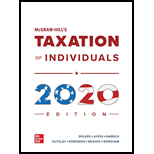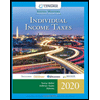
McGraw-Hill's Taxation of Individuals 2020 Edition
11th Edition
ISBN: 9781260432596
Author: SPILKER, Brian
Publisher: MCGRAW-HILL HIGHER EDUCATION
expand_more
expand_more
format_list_bulleted
Question
Chapter 15, Problem 1DQ
To determine
List the most common legal entities that are used for operating a business. Discuss how these entities are similar and different for state law purposes.
Expert Solution & Answer
Explanation of Solution
The following are the most common legal entities that are used for operating a business:
- Corporations.
- Limited liability Companies (LLCs).
Partnerships .- Sole Proprietorships.
The following are the similarity of the above entities for state law purposes:
- The state laws protect all the members or owners of Corporations and LLCs from personal legal entities.
- Corporations, Limited liability Companies (LLCs), and Partnerships are identified as business entities for state law purposes.
The following are the differences among the above entities for state law purposes:
- The legal rights and responsibilities, and number of owners of each entity are different from other.
- The tax rule to determine tax on the entities and their owners are different from each other.
Want to see more full solutions like this?
Subscribe now to access step-by-step solutions to millions of textbook problems written by subject matter experts!
Students have asked these similar questions
DC Co. exchanged equipment and $25,000 cash for similar equipment. The book value and fair value of the old equipment were $120,000 and $135,000, respectively. Assuming that the exchange has commercial substance, DC would record a gain/(loss) of __.
Please show me the valid approach to solving this financial accounting problem with correct methods.
Help with accounting question
Chapter 15 Solutions
McGraw-Hill's Taxation of Individuals 2020 Edition
Knowledge Booster
Similar questions
- Which accounting principle requires that expenses be recorded in the same period as the revenues they help generate?A. Cost PrincipleB. Revenue Recognition PrincipleC. Matching PrincipleD. Full Disclosure Principlearrow_forwardI need guidance with this financial accounting problem using the right financial principles.arrow_forwardWhat is the formula for calculating the weighted average cost of capital (WACC)?A) WACC = (Cost of Debt × Proportion of Debt) + (Cost of Equity × Proportion of Equity)B) WACC = (Cost of Debt + Cost of Equity) / 2C) WACC = Cost of Debt + Cost of EquityD) WACC = Proportion of Debt + Proportion of Equityarrow_forward
- If a company has annual sales of $840,000 with a gross profit margin of 35%, what is the cost of goods sold?arrow_forwardKindly help me with general accounting questionarrow_forwardA business purchased a machine for $120,000 with an estimated useful life of 8 years and salvage value of $24,000. What is the annual straight-line depreciation amount? Helparrow_forward
- Windsor Manufacturing had budgeted overhead costs of $420,000 for the year. The company applied $420,000 of overhead, but the actual overhead incurred amounted to $435,000. Based on this information, what are the fixed overhead price variance for Windsor Manufacturing?arrow_forwardFinancial Accounting Questionarrow_forwardPlease provide the answer to this general accounting question using the right approach.arrow_forward
arrow_back_ios
SEE MORE QUESTIONS
arrow_forward_ios
Recommended textbooks for you
- Century 21 Accounting Multicolumn JournalAccountingISBN:9781337679503Author:GilbertsonPublisher:Cengage
 Individual Income TaxesAccountingISBN:9780357109731Author:HoffmanPublisher:CENGAGE LEARNING - CONSIGNMENT
Individual Income TaxesAccountingISBN:9780357109731Author:HoffmanPublisher:CENGAGE LEARNING - CONSIGNMENT

Century 21 Accounting Multicolumn Journal
Accounting
ISBN:9781337679503
Author:Gilbertson
Publisher:Cengage


Individual Income Taxes
Accounting
ISBN:9780357109731
Author:Hoffman
Publisher:CENGAGE LEARNING - CONSIGNMENT


